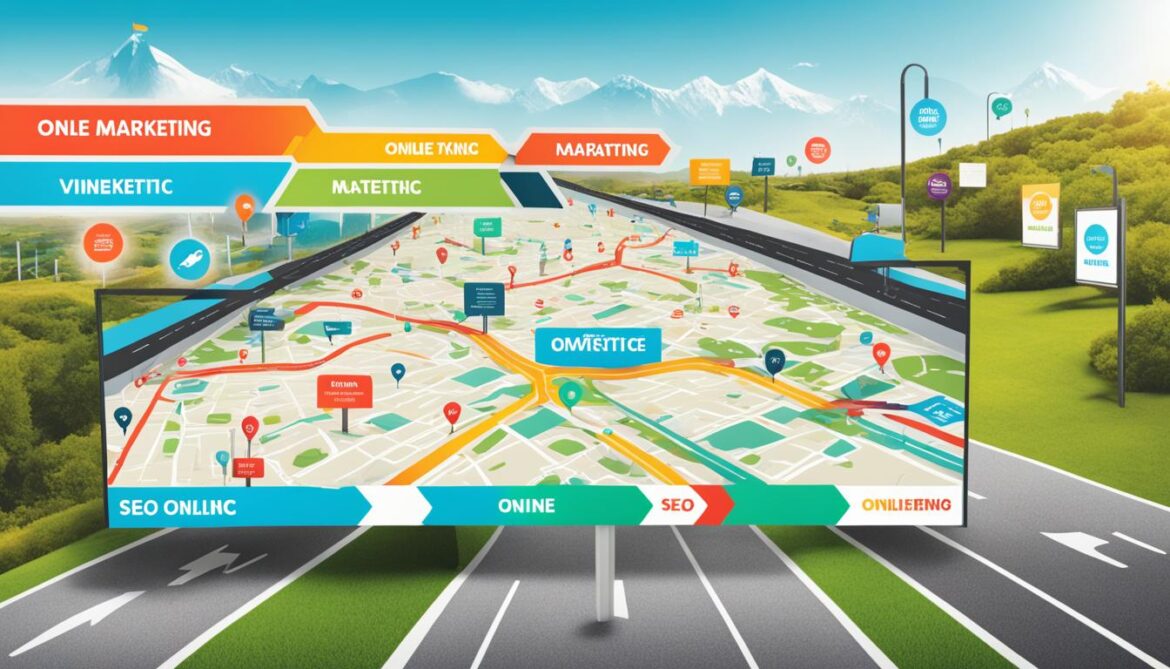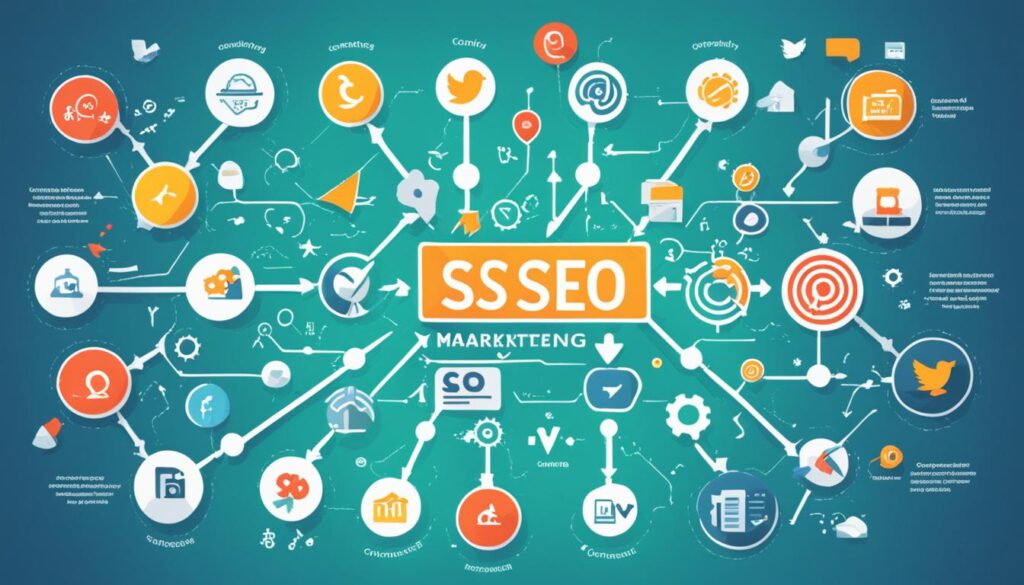
Anyone in business, big or small, should know how these strategies work. This knowledge helps in making smart marketing choices.
Online marketing uses many tools like SEO, social media, and ads to connect with people. SEO, on the other hand, is about making your website more visible in searches. It’s a way to stand out online.
Creating a strong online presence is key today. It lets you reach more people and grow your business. Online marketing and SEO combined can do wonders. They help get your message out there and bring in the right customers.
We’ll look at how online marketing and SEO are different and what they offer. We’ll also see how they team up for better results. So, let’s start exploring the online marketing and SEO world!
SEO vs SEM: What’s The Difference?
When you aim to boost your online presence and website visits, SEO and SEM stand out. Each is key but works in its own way. We’ll look deeper to understand how SEO and SEM are different.
SEO – Search Engine Optimization
SEO stands for Search Engine Optimization. It focuses on adjusting your site to rank better in search results. The aim is to catch Google’s eye. This way, your site shows up higher when people search for specific topics.
This strategy includes tweaking your site inside and out. You do this by using the right keywords, getting linked from other sites, and making your site quick and easy to use. These steps help boost your site’s visibility without paying for ads.
SEM – Search Engine Marketing
SEM covers more ground. It involves SEO and adds paying for ads to the mix. The goal is to get visitors through search results and ads.
Unlike SEO’s slow but steady approach, SEM can deliver fast wins with ads. You pick keywords and pay to show up at the top of search results. Each click on your ad costs money, hence the name Pay-Per-Click.
It’s a powerful tool for certain needs. Want to highlight a special deal or run a focused ad campaign? SEM is your go-to choice for quick results.
In short, SEO fine-tunes your site for free search rankings, while SEM uses both free and paid tactics to get more eyes on your site.
Now that we see what sets SEO and SEM apart, let’s dig deeper. We’ll look at how these methods can help your online marketing stand out.
SEO Overview
SEO stands for Search Engine Optimization. It is the process of making a website show up better in search engines. It aims to boost a site’s visibility on platforms like Google. This is done through different techniques.
These methods include on-page SEO, off-page SEO, technical SEO, and user interaction signs. When used well, they can help a site get more visitors.
On-page SEO focuses on the web content and tags. It’s vital to pick the right keywords and offer useful information. Meta tags, like the title and description, help search engines and people understand the site’s topic.
Off-page SEO is about getting other sites to link back to yours. These links show that others trust your content. The more trustworthy sites that link to yours, the better it is for your site’s visibility.
Technical SEO works on the behind-the-scenes elements of a website. This means making sure things like the site’s structure, its speed, and its mobile-friendliness are top-notch. A well-structured site that’s easy to use can rank higher in online searches.
User interaction with a site also affects its rank. Things like how long people stay on a page and if they visit more than one page matter. A site that keeps visitors interested and engaged is likely to be seen more favorably by search engines.
SEM Overview
SEM means Search Engine Marketing. It combines SEO and PPC ads. With SEM, companies can boost their online visibility and draw in more visitors to their sites.
This strategy uses both natural and paid methods to get noticed on Google and Bing. It helps businesses connect with potential customers in many ways. This makes it easier for them to be seen more online.

For SEM to work well, there are critical elements:
- PPC bidding: This is about placing bids on keywords to get your ads at the top of search results. Smart bidding strategies help companies use their ad money better. They can then get seen by more potential customers.
- Quality score evaluation: Search engines look at how good your ads and landing pages are. This score affects where your ad shows up. If your ads are high-quality, you could pay less and get a better spot.
- Compelling ad copy: Writing ads that really catch people’s attention is key. An ad should show why a product or service is great. It should also encourage people to click and learn more.
- Ad groups: Grouping your ads into themes or keywords lets you aim messages better. This way, you speak directly to different customer groups. It helps to make your ads more effective.
- Account management: Managing your SEM accounts well is crucial. This involves checking how your campaigns are doing and making changes. By keeping an eye on the data, you can make your ads work even better.
With a solid SEM plan, companies can stand out on search engines. This boosts their chances of turning potential customers into actual buyers.
SEO vs SEM: How Long It Takes to See Results
SEO and SEM are both strong in digital marketing. They bring different results in various amounts of time.
SEO is a strategy for the long haul. It needs time to get recognized by search engines. They must find, judge, and place your website in search results. It could take months, maybe years, for new websites to show up on Google’s first page.
For quicker growth, focus on long-tail keywords. Also, follow the best SEO practices. You can see improvements in a few months by doing this. But, remember, it’s constant work. You have to keep an eye on how you’re doing, adjust, and keep improving your site’s reputation.
SEM, like PPC, brings fast outcomes. You can start ad campaigns and begin getting clicks and sales immediately. Once your ads are up, you can connect with your audience and see quick results. This easily makes PPC a top choice for those wanting fast success and immediate presence.
But, don’t forget, SEM needs continuous care and money. You have to keep investing in ads to remain visible in the paid search results.
In the end, SEO offers slow but steady wins. SEM, especially PPC, provides quick outcomes. Both are valuable, depending on your goals, budget, and time. Choosing the right mix of SEO and SEM can greatly improve your digital marketing success.
SEO vs SEM: How Much They Cost
Understanding the costs of SEO and SEM is key when budgeting for digital marketing. SEO can be cheap for bringing in organic visitors. But it still needs lots of time and effort. And, there are costs involved.
For SEO, you need good content, linking websites, and optimizing your site. This can be costly. You must keep updating your content. And, making sure your site is easy for search engines is a must. Also, getting other sites to link to yours is an ongoing investment.
SEM, on the other hand, is about paid advertising. It involves setting budgets for PPC campaigns. You can control how visible you are in search results with SEM. But this control comes with a cost. You must pay to show up and then manage the ads to make sure they work.
SEO’s benefits can keep giving, once you’ve ranked well. But SEM needs constant investment. You keep paying for clicks on your ads. This can get expensive over time.
The right choice between SEO and SEM relies on your goals, budget, and time frame. It’s crucial to fully understand your needs and capabilities. This way, you can make the best use of your resources in digital marketing.
SEO or PPC: What to Focus On
Picking between SEO and PPC for your marketing is tough. Think about your budget and goals first. If you want long-term success without paying right away, SEO is a great choice. It brings in visitors naturally, cutting your PPC costs.
For SEO to work well, make valuable content. Use the right keywords people search for and get others to link to your site. This boosts your site’s traffic and makes it easier to find online.
But, PPC is best for those who can spend steadily and want quick wins. It puts your ad up fast, driving more people to your site. To do PPC well, manage an Adwords account and spend your money wisely. This gets you more specific visitors and sales.

The choice depends on what you need right now, your budget, and how long you can wait to see results. Mixing SEO and PPC can really boost your marketing. It draws in the right people and makes the most of your digital efforts.
What Do Digital Marketers Do?
Digital marketers help companies sell their products online. They manage and run digital marketing campaigns. This includes creating ads and content to attract new customers.
- Content Creation: They know how to make interesting content. This could be blogs, social media posts, or emails. Their goal is to get people interested in what the company offers.
- Search Engine Optimization (SEO): Making content easier to find on the internet is important. By using special techniques, they can make a company show up more in search results. This brings in more visitors without needing to pay for ads.
- Social Media Management: They are also great at handling social media. They make posts and manage the company’s image online. This helps them connect with people who might be interested in what they sell.
- Paid Advertising: Sometimes, they use ads on Google or Facebook to reach more people. They decide where to put ads and make sure they’re working well. This helps the company get more customers by clicking on the ads.
- Analytics and Reporting: Understanding if marketing efforts work is very important. Digital marketers use tools to look at data and see what’s effective. They then share this information with others in the company.
By looking at what customers do and studying the market, digital marketers create plans that work. With their help, companies can do better online. They know how to find the right people and show them what the company has to offer.
What is an Example of Digital Marketing?
Digital marketing uses many strategies to interact with customers online. It includes social media, content, email, SEO, SEM, and display ads.
Social media marketing uses platforms like Facebook and Instagram. It helps in promoting products, interacting with customers, and creating brand awareness. Engaging content can draw people to a business’s website or store online.
Content marketing shares useful materials like blog posts and videos. Its goal is to interest, educate, and entertain the audience. Businesses use this to show expertise and earn customer trust.
Email marketing sends personalized messages to potential and current customers. It nurtures leads and fosters customer loyalty. It’s a key part of staying connected with people online.
SEO makes websites more visible on search engines like Google. It focuses on using the right keywords, creating quality content, and getting backlinks. This attracts visitors who are looking for what the business offers.
SEM includes SEO and paid ads, like those seen using Google AdWords. It’s about choosing the right search terms, demographics, and locations to bring in the right people. This approach helps businesses be visible to their potential customers.
Display ads are visual banners or videos seen on websites or social media. They’re a way for businesses to get their messages in front of their target audience. It’s an effective means to raise brand profile.
Using these digital marketing methods, businesses can connect with their audience and meet their goals. They can draw people to their sites or shops and grow their brand.
Conclusion
Online marketing and SEO are crucial for a strong online presence. Online marketing includes SEO, social media ads, and content creation. SEO, on the other hand, is about making your site better for search engines.
SEO and SEM each have their own pros and cons. Using both in a smart way helps your business stand out online. It boosts your search rankings and brings more people to your site.
By combining online marketing, SEO, and SEM, you build a solid digital plan. It helps you get in front of the right people and turn them into customers. This approach grows your business online.


